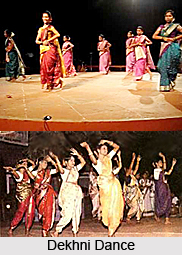 Dekhni is a semi classical Goan dance form. It is also pronounced as Dekni or Dekni. Dekhni represents an attractive mixture of Indian melody and Western rhythm. It is mainly performed by Christian girls adorned in Indian attires. It is a song cum dance popular in Goa. Dekhni dance usually enacts the life of a Devdasi girl meaning servant of God whose job is to perform dance in temples and social ceremonies like weddings. One of the popular Dekhni songs is Hanv Saiba Poltodi Vetam by Carlos Eugenio Ferreira (1860-1926) first published in Paris in 1895 and then in Goa in 1926.
Dekhni is a semi classical Goan dance form. It is also pronounced as Dekni or Dekni. Dekhni represents an attractive mixture of Indian melody and Western rhythm. It is mainly performed by Christian girls adorned in Indian attires. It is a song cum dance popular in Goa. Dekhni dance usually enacts the life of a Devdasi girl meaning servant of God whose job is to perform dance in temples and social ceremonies like weddings. One of the popular Dekhni songs is Hanv Saiba Poltodi Vetam by Carlos Eugenio Ferreira (1860-1926) first published in Paris in 1895 and then in Goa in 1926.
Etymology of Dekhni
The word `Dekhni` means `bewitching beauty` in Konkani language.
History of Dekhni Dance
It is believed that this dance has its origin in the Devadasi system of the Goans as they follow the Devadasi system. According to this system, some women dedicate their life for the service of God. They also don"t marry or have families of their own. They perform in temples and in front of God and so this dance has been around for a long time.
Theme of Dekhni Dance
The theme is of a Devdasi girl who comes to a riverbank to take a ferry to reach the other side where she has an appointment to dance in a wedding. She requests the boatman to take her to the other side of the river. The boatman rejects and says as the water is rough it would be unsafe to travel. The Devdasi keeps requesting him and is even ready to offer him her golden earring for taking her across urgently. So the dancers dance for the boatman and this time he ferries them across the river.
Performance of Dekhni Dance
It is performed exclusively by women-folk. The dance is set in combination of western rhythms and Indian melody. Some of the gestures of this dance have been borrowed from classical dances like Kathak and Bharata Natyam.
The performance becomes graceful by the conversation between the girl and the boatman in the form of a lilting song. The dancers carry pantis which are small clay lamps with a wick floating in oil or even artis. Only two or three dekhni songs that were composed and scored a long time ago are still existent. The performers dance to the beat of the Ghumat, a folk drum.
One of the first dekhni dances Kuxttoba can be dated back to around 1869. The song calls out in the song `heir to India and terror of Goa` which implies resistance to Portuguese rule. Kuxttoba was a member of the Salekar branch of the Rane family. This dance is much performed throughout Goa.



















